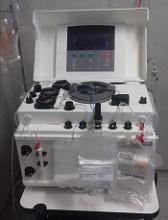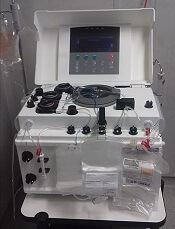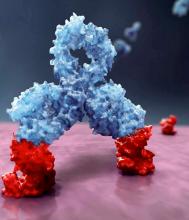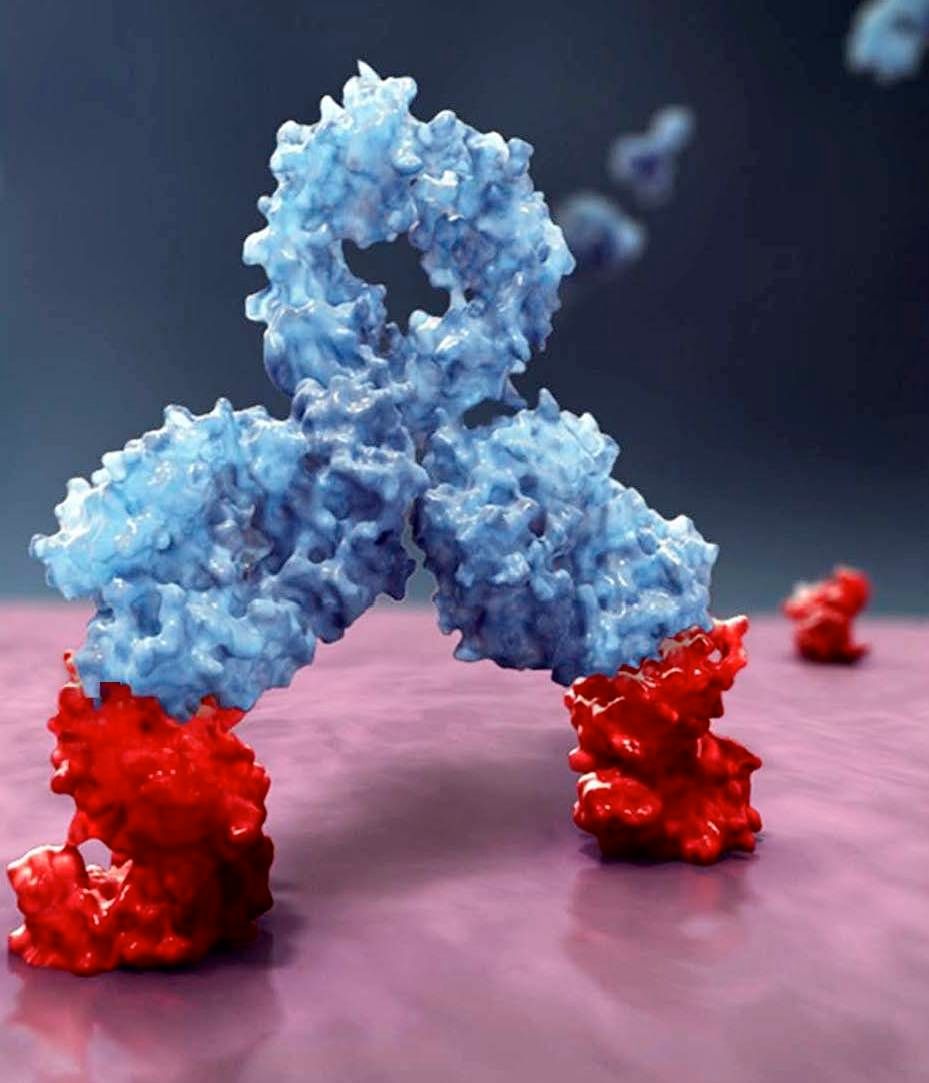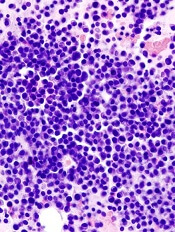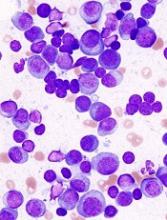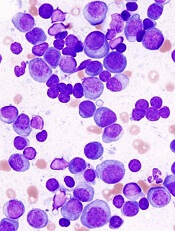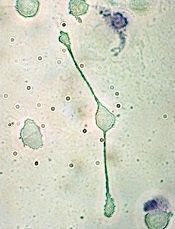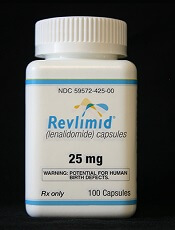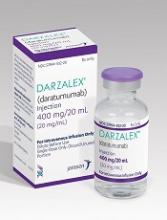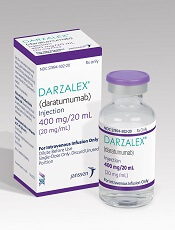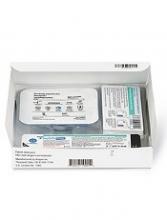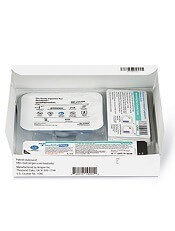User login
Auto-HSCT linked to higher AML, MDS risk
Patients undergoing autologous hematopoietic stem cell transplant (auto-HSCT) for lymphoma or myeloma have an increased risk of acute myeloid leukemia (AML) and myelodysplastic syndromes (MDS), according to a retrospective study.
The study suggested these patients have 10 to 100 times the risk of AML or MDS as the general population.
The elevated risk also exceeds that of similar lymphoma and myeloma patients largely untreated with auto-HSCT.
Tomas Radivoyevitch, PhD, of the Cleveland Clinic Foundation in Ohio, and his colleagues reported these findings in Leukemia Research.
The investigators noted that exposure to DNA-damaging drugs and ionizing radiation—both used in auto-HSCT—is known to increase the risk of AML and MDS.
With this in mind, the team analyzed data on auto-HSCT recipients reported to the Center for International Blood and Marrow Transplant Research (CIBMTR).
Analyses were based on 9028 patients undergoing auto-HSCT from 1995 to 2010 for Hodgkin lymphoma (n=916), non-Hodgkin lymphoma (NHL, n=3546), or plasma cell myeloma (n=4566). Their median duration of follow-up was 90 months, 110 months, and 97 months, respectively.
Overall, 3.7% of the cohort developed AML or MDS after their transplant.
More aggressive transplant protocols increased the likelihood of this outcome. The risk of developing AML or MDS was higher for:
- Hodgkin lymphoma patients who received conditioning with total body radiation versus chemotherapy alone (hazard ratio [HR], 4.0)
- NHL patients who received conditioning with total body radiation (HR, 1.7) or with busulfan and melphalan or cyclophosphamide (HR, 1.8) versus the BEAM regimen (bischloroethylnitrosourea, etoposide, cytarabine, and melphalan)
- NHL or myeloma patients who received 3 or more lines of chemotherapy versus 1 line (HR, 1.9 for NHL and 1.8 for myeloma)
- NHL patients who underwent transplant in 2005 to 2010 versus 1995 to 1999 (HR, 2.1).
Patients reported to the Surveillance, Epidemiology and End Results database with the same lymphoma and myeloma diagnoses, few of whom underwent auto-HSCT, had risks of AML and MDS that were 5 to 10 times higher than the background level in the population.
However, the study auto-HSCT cohort had a risk of AML that was 10 to 50 times higher and a relative risk of MDS that was roughly 100 times higher than the background level.
“These increases may be related to exposure to high doses of DNA-damaging drugs given for [auto-HSCT], but this hypothesis can only be tested in a prospective study,” Dr Radivoyevitch and his coinvestigators wrote.
The reason for the greater elevation of MDS risk, compared with AML risk, is unknown.
“One possible explanation is that many cases of MDS evolve to AML, and that earlier diagnosis from increased post-transplant surveillance resulted in a deficiency of AML,” the investigators wrote. “A second is based on steeper MDS versus AML incidences versus age . . . and the possibility that transplantation recipient marrow ages (ie, marrow biological ages) are perhaps decades older than calendar ages.”
The study authors said they had no relevant conflicts of interest. The CIBMTR is supported by several US government agencies and numerous pharmaceutical companies.
Patients undergoing autologous hematopoietic stem cell transplant (auto-HSCT) for lymphoma or myeloma have an increased risk of acute myeloid leukemia (AML) and myelodysplastic syndromes (MDS), according to a retrospective study.
The study suggested these patients have 10 to 100 times the risk of AML or MDS as the general population.
The elevated risk also exceeds that of similar lymphoma and myeloma patients largely untreated with auto-HSCT.
Tomas Radivoyevitch, PhD, of the Cleveland Clinic Foundation in Ohio, and his colleagues reported these findings in Leukemia Research.
The investigators noted that exposure to DNA-damaging drugs and ionizing radiation—both used in auto-HSCT—is known to increase the risk of AML and MDS.
With this in mind, the team analyzed data on auto-HSCT recipients reported to the Center for International Blood and Marrow Transplant Research (CIBMTR).
Analyses were based on 9028 patients undergoing auto-HSCT from 1995 to 2010 for Hodgkin lymphoma (n=916), non-Hodgkin lymphoma (NHL, n=3546), or plasma cell myeloma (n=4566). Their median duration of follow-up was 90 months, 110 months, and 97 months, respectively.
Overall, 3.7% of the cohort developed AML or MDS after their transplant.
More aggressive transplant protocols increased the likelihood of this outcome. The risk of developing AML or MDS was higher for:
- Hodgkin lymphoma patients who received conditioning with total body radiation versus chemotherapy alone (hazard ratio [HR], 4.0)
- NHL patients who received conditioning with total body radiation (HR, 1.7) or with busulfan and melphalan or cyclophosphamide (HR, 1.8) versus the BEAM regimen (bischloroethylnitrosourea, etoposide, cytarabine, and melphalan)
- NHL or myeloma patients who received 3 or more lines of chemotherapy versus 1 line (HR, 1.9 for NHL and 1.8 for myeloma)
- NHL patients who underwent transplant in 2005 to 2010 versus 1995 to 1999 (HR, 2.1).
Patients reported to the Surveillance, Epidemiology and End Results database with the same lymphoma and myeloma diagnoses, few of whom underwent auto-HSCT, had risks of AML and MDS that were 5 to 10 times higher than the background level in the population.
However, the study auto-HSCT cohort had a risk of AML that was 10 to 50 times higher and a relative risk of MDS that was roughly 100 times higher than the background level.
“These increases may be related to exposure to high doses of DNA-damaging drugs given for [auto-HSCT], but this hypothesis can only be tested in a prospective study,” Dr Radivoyevitch and his coinvestigators wrote.
The reason for the greater elevation of MDS risk, compared with AML risk, is unknown.
“One possible explanation is that many cases of MDS evolve to AML, and that earlier diagnosis from increased post-transplant surveillance resulted in a deficiency of AML,” the investigators wrote. “A second is based on steeper MDS versus AML incidences versus age . . . and the possibility that transplantation recipient marrow ages (ie, marrow biological ages) are perhaps decades older than calendar ages.”
The study authors said they had no relevant conflicts of interest. The CIBMTR is supported by several US government agencies and numerous pharmaceutical companies.
Patients undergoing autologous hematopoietic stem cell transplant (auto-HSCT) for lymphoma or myeloma have an increased risk of acute myeloid leukemia (AML) and myelodysplastic syndromes (MDS), according to a retrospective study.
The study suggested these patients have 10 to 100 times the risk of AML or MDS as the general population.
The elevated risk also exceeds that of similar lymphoma and myeloma patients largely untreated with auto-HSCT.
Tomas Radivoyevitch, PhD, of the Cleveland Clinic Foundation in Ohio, and his colleagues reported these findings in Leukemia Research.
The investigators noted that exposure to DNA-damaging drugs and ionizing radiation—both used in auto-HSCT—is known to increase the risk of AML and MDS.
With this in mind, the team analyzed data on auto-HSCT recipients reported to the Center for International Blood and Marrow Transplant Research (CIBMTR).
Analyses were based on 9028 patients undergoing auto-HSCT from 1995 to 2010 for Hodgkin lymphoma (n=916), non-Hodgkin lymphoma (NHL, n=3546), or plasma cell myeloma (n=4566). Their median duration of follow-up was 90 months, 110 months, and 97 months, respectively.
Overall, 3.7% of the cohort developed AML or MDS after their transplant.
More aggressive transplant protocols increased the likelihood of this outcome. The risk of developing AML or MDS was higher for:
- Hodgkin lymphoma patients who received conditioning with total body radiation versus chemotherapy alone (hazard ratio [HR], 4.0)
- NHL patients who received conditioning with total body radiation (HR, 1.7) or with busulfan and melphalan or cyclophosphamide (HR, 1.8) versus the BEAM regimen (bischloroethylnitrosourea, etoposide, cytarabine, and melphalan)
- NHL or myeloma patients who received 3 or more lines of chemotherapy versus 1 line (HR, 1.9 for NHL and 1.8 for myeloma)
- NHL patients who underwent transplant in 2005 to 2010 versus 1995 to 1999 (HR, 2.1).
Patients reported to the Surveillance, Epidemiology and End Results database with the same lymphoma and myeloma diagnoses, few of whom underwent auto-HSCT, had risks of AML and MDS that were 5 to 10 times higher than the background level in the population.
However, the study auto-HSCT cohort had a risk of AML that was 10 to 50 times higher and a relative risk of MDS that was roughly 100 times higher than the background level.
“These increases may be related to exposure to high doses of DNA-damaging drugs given for [auto-HSCT], but this hypothesis can only be tested in a prospective study,” Dr Radivoyevitch and his coinvestigators wrote.
The reason for the greater elevation of MDS risk, compared with AML risk, is unknown.
“One possible explanation is that many cases of MDS evolve to AML, and that earlier diagnosis from increased post-transplant surveillance resulted in a deficiency of AML,” the investigators wrote. “A second is based on steeper MDS versus AML incidences versus age . . . and the possibility that transplantation recipient marrow ages (ie, marrow biological ages) are perhaps decades older than calendar ages.”
The study authors said they had no relevant conflicts of interest. The CIBMTR is supported by several US government agencies and numerous pharmaceutical companies.
Janssen seeks approval for split dosing of daratumumab
Janssen has applied to the Food and Drug Administration and the European Medicines Agency to allow splitting of the first infusion of daratumumab (Darzalex) in multiple myeloma patients over 2 consecutive days.
The goal is to improve the treatment experience for patients and physicians, according to the announcement from Janssen.
The regulatory submissions are based on the global, multi-arm, phase 1b MMY1001 study (NCT01998971). The study evaluated daratumumab in combination with various other treatments in 240 patients with multiple myeloma. It found that both the safety profile and the pharmacokinetics concentrations seen with either single dosing or split dosing were similar.
Daratumumab is the first approved monoclonal antibody that targets CD38, which is expressed across multiple myeloma cells regardless of disease stage. Daratumumab is currently approved for treatment of multiple myeloma in both the United States and the European Union either as monotherapy or in conjunction with other treatments.
Daratumumab is known to sometimes cause severe/serious infusion reactions, such as anaphylactic reactions; interfere with serological testing; and cause neutropenia or thrombocytopenia.
Janssen has applied to the Food and Drug Administration and the European Medicines Agency to allow splitting of the first infusion of daratumumab (Darzalex) in multiple myeloma patients over 2 consecutive days.
The goal is to improve the treatment experience for patients and physicians, according to the announcement from Janssen.
The regulatory submissions are based on the global, multi-arm, phase 1b MMY1001 study (NCT01998971). The study evaluated daratumumab in combination with various other treatments in 240 patients with multiple myeloma. It found that both the safety profile and the pharmacokinetics concentrations seen with either single dosing or split dosing were similar.
Daratumumab is the first approved monoclonal antibody that targets CD38, which is expressed across multiple myeloma cells regardless of disease stage. Daratumumab is currently approved for treatment of multiple myeloma in both the United States and the European Union either as monotherapy or in conjunction with other treatments.
Daratumumab is known to sometimes cause severe/serious infusion reactions, such as anaphylactic reactions; interfere with serological testing; and cause neutropenia or thrombocytopenia.
Janssen has applied to the Food and Drug Administration and the European Medicines Agency to allow splitting of the first infusion of daratumumab (Darzalex) in multiple myeloma patients over 2 consecutive days.
The goal is to improve the treatment experience for patients and physicians, according to the announcement from Janssen.
The regulatory submissions are based on the global, multi-arm, phase 1b MMY1001 study (NCT01998971). The study evaluated daratumumab in combination with various other treatments in 240 patients with multiple myeloma. It found that both the safety profile and the pharmacokinetics concentrations seen with either single dosing or split dosing were similar.
Daratumumab is the first approved monoclonal antibody that targets CD38, which is expressed across multiple myeloma cells regardless of disease stage. Daratumumab is currently approved for treatment of multiple myeloma in both the United States and the European Union either as monotherapy or in conjunction with other treatments.
Daratumumab is known to sometimes cause severe/serious infusion reactions, such as anaphylactic reactions; interfere with serological testing; and cause neutropenia or thrombocytopenia.
Comprehensive sequencing informs treatment for MM
A comprehensive RNA and DNA sequencing platform can guide treatment decisions for late-stage and drug-resistant multiple myeloma (MM), according to a study published in JCO Precision Oncology.
Researchers used the platform to generate treatment suggestions for 64 MM patients who had exhausted all approved treatment options.
Of the 21 evaluable patients who received the sequencing-recommended therapies, 67% achieved a response. Five patients had ongoing responses at the end of the trial.
“Our study shows how a precision medicine approach incorporating RNA sequencing may identify viable and effective therapeutic options beyond the current FDA-approved armamentarium for multiple myeloma patients,” said study author Samir Parekh, MD, of the Icahn School of Medicine at Mount Sinai in New York, New York.
“The trial has allowed us to test the accuracy of our platform, laying the foundation for our next-generation precision medicine framework.”
Dr Parekh and his colleagues used DNA and RNA sequencing data to generate personalized treatment recommendations for 64 heavily pretreated MM patients.
The patients had received a median of 7 lines of therapy. Most patients (61%) were male, their median age was 59 (range, 40-85), and 67% had high-risk cytogenetics.
The sequencing data yielded treatment recommendations for 63 patients. Twenty-six patients (42%) actually received at least 1 of the recommended treatments.
The treatments (given alone or in combination) were:
- Trametinib (n=16)—recommended because of mutations in NRAS or KRAS
- Venetoclax (n=8)—recommended because of high BCL2 expression
- Panobinostat (n=6)—recommended due to activation of the HDAC pathway and/or by RNA-based drug repurposing selecting the pan-HDAC inhibitor vorinostat
- Dabrafenib (n=1)—recommended because of concurrent BRAF and RAS mutations
- Etoposide (n=2)—selected by RNA-based drug repurposing.
Twenty-one patients were evaluable for response. The researchers noted that 11 of these patients received treatment based on RNA findings, 8 based on DNA, and 2 based on both.
One patient achieved a complete response, 3 had a very good partial response, 10 had a partial response, 2 had a minimal response (25% reduction of disease marker), 3 had stable disease, and 2 progressed.
That means the overall response rate was 66.6% (14/21), and the clinical benefit rate (minimal response or better) was 76.2% (16/21).
The median duration of response was 131 days (range, 37-372), and 5 patients were still in response at the end of the study (September, 1, 2017).
Mount Sinai researchers have received funding to develop a clinical trial that will incorporate machine learning algorithms into this precision medicine platform, which will implement interactive learning techniques to refine the predictions based on a patient’s success with the therapies and a physician’s opinion of the treatment plan.
“This research is part of an accelerating paradigm shift in cancer therapy where treatment may be given based on the specific genomic alterations observed in a patient’s tumor rather than on the tumor histology or tissue type,” said study author Joel Dudley, PhD, of the Icahn School of Medicine at Mount Sinai.
“RNA sequencing will likely complement current precision medicine strategies in the near future due to its ability to capture more dynamic aspects of unique tumor biology and provide information beyond what is capable with DNA alone.”
A comprehensive RNA and DNA sequencing platform can guide treatment decisions for late-stage and drug-resistant multiple myeloma (MM), according to a study published in JCO Precision Oncology.
Researchers used the platform to generate treatment suggestions for 64 MM patients who had exhausted all approved treatment options.
Of the 21 evaluable patients who received the sequencing-recommended therapies, 67% achieved a response. Five patients had ongoing responses at the end of the trial.
“Our study shows how a precision medicine approach incorporating RNA sequencing may identify viable and effective therapeutic options beyond the current FDA-approved armamentarium for multiple myeloma patients,” said study author Samir Parekh, MD, of the Icahn School of Medicine at Mount Sinai in New York, New York.
“The trial has allowed us to test the accuracy of our platform, laying the foundation for our next-generation precision medicine framework.”
Dr Parekh and his colleagues used DNA and RNA sequencing data to generate personalized treatment recommendations for 64 heavily pretreated MM patients.
The patients had received a median of 7 lines of therapy. Most patients (61%) were male, their median age was 59 (range, 40-85), and 67% had high-risk cytogenetics.
The sequencing data yielded treatment recommendations for 63 patients. Twenty-six patients (42%) actually received at least 1 of the recommended treatments.
The treatments (given alone or in combination) were:
- Trametinib (n=16)—recommended because of mutations in NRAS or KRAS
- Venetoclax (n=8)—recommended because of high BCL2 expression
- Panobinostat (n=6)—recommended due to activation of the HDAC pathway and/or by RNA-based drug repurposing selecting the pan-HDAC inhibitor vorinostat
- Dabrafenib (n=1)—recommended because of concurrent BRAF and RAS mutations
- Etoposide (n=2)—selected by RNA-based drug repurposing.
Twenty-one patients were evaluable for response. The researchers noted that 11 of these patients received treatment based on RNA findings, 8 based on DNA, and 2 based on both.
One patient achieved a complete response, 3 had a very good partial response, 10 had a partial response, 2 had a minimal response (25% reduction of disease marker), 3 had stable disease, and 2 progressed.
That means the overall response rate was 66.6% (14/21), and the clinical benefit rate (minimal response or better) was 76.2% (16/21).
The median duration of response was 131 days (range, 37-372), and 5 patients were still in response at the end of the study (September, 1, 2017).
Mount Sinai researchers have received funding to develop a clinical trial that will incorporate machine learning algorithms into this precision medicine platform, which will implement interactive learning techniques to refine the predictions based on a patient’s success with the therapies and a physician’s opinion of the treatment plan.
“This research is part of an accelerating paradigm shift in cancer therapy where treatment may be given based on the specific genomic alterations observed in a patient’s tumor rather than on the tumor histology or tissue type,” said study author Joel Dudley, PhD, of the Icahn School of Medicine at Mount Sinai.
“RNA sequencing will likely complement current precision medicine strategies in the near future due to its ability to capture more dynamic aspects of unique tumor biology and provide information beyond what is capable with DNA alone.”
A comprehensive RNA and DNA sequencing platform can guide treatment decisions for late-stage and drug-resistant multiple myeloma (MM), according to a study published in JCO Precision Oncology.
Researchers used the platform to generate treatment suggestions for 64 MM patients who had exhausted all approved treatment options.
Of the 21 evaluable patients who received the sequencing-recommended therapies, 67% achieved a response. Five patients had ongoing responses at the end of the trial.
“Our study shows how a precision medicine approach incorporating RNA sequencing may identify viable and effective therapeutic options beyond the current FDA-approved armamentarium for multiple myeloma patients,” said study author Samir Parekh, MD, of the Icahn School of Medicine at Mount Sinai in New York, New York.
“The trial has allowed us to test the accuracy of our platform, laying the foundation for our next-generation precision medicine framework.”
Dr Parekh and his colleagues used DNA and RNA sequencing data to generate personalized treatment recommendations for 64 heavily pretreated MM patients.
The patients had received a median of 7 lines of therapy. Most patients (61%) were male, their median age was 59 (range, 40-85), and 67% had high-risk cytogenetics.
The sequencing data yielded treatment recommendations for 63 patients. Twenty-six patients (42%) actually received at least 1 of the recommended treatments.
The treatments (given alone or in combination) were:
- Trametinib (n=16)—recommended because of mutations in NRAS or KRAS
- Venetoclax (n=8)—recommended because of high BCL2 expression
- Panobinostat (n=6)—recommended due to activation of the HDAC pathway and/or by RNA-based drug repurposing selecting the pan-HDAC inhibitor vorinostat
- Dabrafenib (n=1)—recommended because of concurrent BRAF and RAS mutations
- Etoposide (n=2)—selected by RNA-based drug repurposing.
Twenty-one patients were evaluable for response. The researchers noted that 11 of these patients received treatment based on RNA findings, 8 based on DNA, and 2 based on both.
One patient achieved a complete response, 3 had a very good partial response, 10 had a partial response, 2 had a minimal response (25% reduction of disease marker), 3 had stable disease, and 2 progressed.
That means the overall response rate was 66.6% (14/21), and the clinical benefit rate (minimal response or better) was 76.2% (16/21).
The median duration of response was 131 days (range, 37-372), and 5 patients were still in response at the end of the study (September, 1, 2017).
Mount Sinai researchers have received funding to develop a clinical trial that will incorporate machine learning algorithms into this precision medicine platform, which will implement interactive learning techniques to refine the predictions based on a patient’s success with the therapies and a physician’s opinion of the treatment plan.
“This research is part of an accelerating paradigm shift in cancer therapy where treatment may be given based on the specific genomic alterations observed in a patient’s tumor rather than on the tumor histology or tissue type,” said study author Joel Dudley, PhD, of the Icahn School of Medicine at Mount Sinai.
“RNA sequencing will likely complement current precision medicine strategies in the near future due to its ability to capture more dynamic aspects of unique tumor biology and provide information beyond what is capable with DNA alone.”
Tool identifies potential treatment for resistant MM
Researchers say they have developed a computational platform that can be used to identify optimal treatments for multiple myeloma (MM).
Using this tool, the quadratic phenotypic optimization platform (QPOP), the researchers identified a 2-drug combination that proved effective against bortezomib-resistant MM in vitro.
The combination—decitabine and mitomycin C—also decreased tumor volume and prolonged survival in a mouse model of bortezomib-resistant MM.
Masturah Bte Mohd Abdul Rashid, of the Cancer Science Institute of Singapore, and her colleagues reported these results in Science Translational Medicine.
The researchers explained that QPOP approximates biological responses to therapies using advanced mathematical equations. Unlike conventional models, QPOP doesn’t require predetermined information about the mechanisms or composition of a drug.
To test QPOP’s utility in MM, the researchers began by identifying candidate drugs that might be effective against bortezomib-resistant MM. They screened 114 approved oncology drugs on 2 MM cell lines—RPMI 8226 and bortezomib-resistant RPMI 8226 (P100v).
The drugs that proved most effective against P100v were dactinomycin, decitabine, mechlorethamine hydrochloride, and mitomycin C.
The researchers wanted to identify optimal drug combinations, so they conducted a QPOP analysis including the 4 most effective drugs and an additional 10 drugs used to treat MM. The 10 drugs were bortezomib, carfilzomib, cyclophosphamide monohydrate, dexamethasone, doxorubucin, lenalidomide, panobinostat, plerixafor, thalidomide, and zoledronic acid.
The team tested 2 dosages of the 14 drugs in 128 combinations, then narrowed the list to 9 drugs and tested them at 3 dosages in 155 combinations.
This revealed the top 3 combinations:
- Decitabine and mitomycin C
- Mechlorethamine hydrochloride, decitabine, and mitomycin C
- Bortezomib, mechlorethamine hydrochloride, and mitomycin C.
The researchers said these combinations act by reversing the DNA methylation and tumor suppressor silencing that often occurs after acquired bortezomib resistance.
The team noted that the top 3 combinations had synergistic interactions, but the QPOP analysis revealed antagonistic interactions as well. For example, bortezomib and dexamethasone proved antagonistic, as did bortezomib and panobinostat.
The researchers conducted further testing to determine the optimal dosage of decitabine and mitomycin C. Results suggested both drugs should be given at 1.5 mg/kg.
The team then treated P100v tumor-bearing mice with decitabine and mitomycin C, both at 1.5 mg/kg, either alone or in combination.
Mice that received the combination had a decrease in tumor size and prolonged survival compared to mice that received DMSO (P=0.0130), decitabine alone (P=0.0121), or mitomycin C alone (P=0.00174).
The researchers also compared decitabine and mitomycin C in combination to 2 bortezomib-based combinations used to treat MM—bortezomib/dexamethasone/melphalan and bortezomib/dexamethasone/lenalidomide—in P100v tumor-bearing mice.
There was a significant decrease in tumor volume with decitabine/mitomycin C compared to bortezomib/dexamethasone/melphalan (P=0.000376) and bortezomib/dexamethasone/lenalidomide (P=0.000691).
Mice that received decitabine/mitomycin C had significantly longer survival than mice that received bortezomib/dexamethasone/melphalan (P=0.0389) or bortezomib/dexamethasone/lenalidomide (P=0.0246).
Neither survival times nor tumor volumes were significantly different between the mice that received DMSO and those that received either of the bortezomib-based combinations.
Researchers say they have developed a computational platform that can be used to identify optimal treatments for multiple myeloma (MM).
Using this tool, the quadratic phenotypic optimization platform (QPOP), the researchers identified a 2-drug combination that proved effective against bortezomib-resistant MM in vitro.
The combination—decitabine and mitomycin C—also decreased tumor volume and prolonged survival in a mouse model of bortezomib-resistant MM.
Masturah Bte Mohd Abdul Rashid, of the Cancer Science Institute of Singapore, and her colleagues reported these results in Science Translational Medicine.
The researchers explained that QPOP approximates biological responses to therapies using advanced mathematical equations. Unlike conventional models, QPOP doesn’t require predetermined information about the mechanisms or composition of a drug.
To test QPOP’s utility in MM, the researchers began by identifying candidate drugs that might be effective against bortezomib-resistant MM. They screened 114 approved oncology drugs on 2 MM cell lines—RPMI 8226 and bortezomib-resistant RPMI 8226 (P100v).
The drugs that proved most effective against P100v were dactinomycin, decitabine, mechlorethamine hydrochloride, and mitomycin C.
The researchers wanted to identify optimal drug combinations, so they conducted a QPOP analysis including the 4 most effective drugs and an additional 10 drugs used to treat MM. The 10 drugs were bortezomib, carfilzomib, cyclophosphamide monohydrate, dexamethasone, doxorubucin, lenalidomide, panobinostat, plerixafor, thalidomide, and zoledronic acid.
The team tested 2 dosages of the 14 drugs in 128 combinations, then narrowed the list to 9 drugs and tested them at 3 dosages in 155 combinations.
This revealed the top 3 combinations:
- Decitabine and mitomycin C
- Mechlorethamine hydrochloride, decitabine, and mitomycin C
- Bortezomib, mechlorethamine hydrochloride, and mitomycin C.
The researchers said these combinations act by reversing the DNA methylation and tumor suppressor silencing that often occurs after acquired bortezomib resistance.
The team noted that the top 3 combinations had synergistic interactions, but the QPOP analysis revealed antagonistic interactions as well. For example, bortezomib and dexamethasone proved antagonistic, as did bortezomib and panobinostat.
The researchers conducted further testing to determine the optimal dosage of decitabine and mitomycin C. Results suggested both drugs should be given at 1.5 mg/kg.
The team then treated P100v tumor-bearing mice with decitabine and mitomycin C, both at 1.5 mg/kg, either alone or in combination.
Mice that received the combination had a decrease in tumor size and prolonged survival compared to mice that received DMSO (P=0.0130), decitabine alone (P=0.0121), or mitomycin C alone (P=0.00174).
The researchers also compared decitabine and mitomycin C in combination to 2 bortezomib-based combinations used to treat MM—bortezomib/dexamethasone/melphalan and bortezomib/dexamethasone/lenalidomide—in P100v tumor-bearing mice.
There was a significant decrease in tumor volume with decitabine/mitomycin C compared to bortezomib/dexamethasone/melphalan (P=0.000376) and bortezomib/dexamethasone/lenalidomide (P=0.000691).
Mice that received decitabine/mitomycin C had significantly longer survival than mice that received bortezomib/dexamethasone/melphalan (P=0.0389) or bortezomib/dexamethasone/lenalidomide (P=0.0246).
Neither survival times nor tumor volumes were significantly different between the mice that received DMSO and those that received either of the bortezomib-based combinations.
Researchers say they have developed a computational platform that can be used to identify optimal treatments for multiple myeloma (MM).
Using this tool, the quadratic phenotypic optimization platform (QPOP), the researchers identified a 2-drug combination that proved effective against bortezomib-resistant MM in vitro.
The combination—decitabine and mitomycin C—also decreased tumor volume and prolonged survival in a mouse model of bortezomib-resistant MM.
Masturah Bte Mohd Abdul Rashid, of the Cancer Science Institute of Singapore, and her colleagues reported these results in Science Translational Medicine.
The researchers explained that QPOP approximates biological responses to therapies using advanced mathematical equations. Unlike conventional models, QPOP doesn’t require predetermined information about the mechanisms or composition of a drug.
To test QPOP’s utility in MM, the researchers began by identifying candidate drugs that might be effective against bortezomib-resistant MM. They screened 114 approved oncology drugs on 2 MM cell lines—RPMI 8226 and bortezomib-resistant RPMI 8226 (P100v).
The drugs that proved most effective against P100v were dactinomycin, decitabine, mechlorethamine hydrochloride, and mitomycin C.
The researchers wanted to identify optimal drug combinations, so they conducted a QPOP analysis including the 4 most effective drugs and an additional 10 drugs used to treat MM. The 10 drugs were bortezomib, carfilzomib, cyclophosphamide monohydrate, dexamethasone, doxorubucin, lenalidomide, panobinostat, plerixafor, thalidomide, and zoledronic acid.
The team tested 2 dosages of the 14 drugs in 128 combinations, then narrowed the list to 9 drugs and tested them at 3 dosages in 155 combinations.
This revealed the top 3 combinations:
- Decitabine and mitomycin C
- Mechlorethamine hydrochloride, decitabine, and mitomycin C
- Bortezomib, mechlorethamine hydrochloride, and mitomycin C.
The researchers said these combinations act by reversing the DNA methylation and tumor suppressor silencing that often occurs after acquired bortezomib resistance.
The team noted that the top 3 combinations had synergistic interactions, but the QPOP analysis revealed antagonistic interactions as well. For example, bortezomib and dexamethasone proved antagonistic, as did bortezomib and panobinostat.
The researchers conducted further testing to determine the optimal dosage of decitabine and mitomycin C. Results suggested both drugs should be given at 1.5 mg/kg.
The team then treated P100v tumor-bearing mice with decitabine and mitomycin C, both at 1.5 mg/kg, either alone or in combination.
Mice that received the combination had a decrease in tumor size and prolonged survival compared to mice that received DMSO (P=0.0130), decitabine alone (P=0.0121), or mitomycin C alone (P=0.00174).
The researchers also compared decitabine and mitomycin C in combination to 2 bortezomib-based combinations used to treat MM—bortezomib/dexamethasone/melphalan and bortezomib/dexamethasone/lenalidomide—in P100v tumor-bearing mice.
There was a significant decrease in tumor volume with decitabine/mitomycin C compared to bortezomib/dexamethasone/melphalan (P=0.000376) and bortezomib/dexamethasone/lenalidomide (P=0.000691).
Mice that received decitabine/mitomycin C had significantly longer survival than mice that received bortezomib/dexamethasone/melphalan (P=0.0389) or bortezomib/dexamethasone/lenalidomide (P=0.0246).
Neither survival times nor tumor volumes were significantly different between the mice that received DMSO and those that received either of the bortezomib-based combinations.
Company stops development of drug for MM
MorphoSys AG has decided to stop developing MOR202 as a treatment for multiple myeloma (MM).
However, MorphoSys said it will complete the ongoing phase 1/2a trial of MOR202, and I-Mab Biopharma will continue developing MOR202 as an MM therapy for the Greater China region.
MOR202 is a human monoclonal HuCAL antibody directed against CD38, a validated target in MM.
MorphoSys is testing MOR202 in combination with other drugs in a phase 1/2a trial of patients with relapsed/refractory MM (NCT01421186).
The patients were assigned to receive MOR202 plus dexamethasone (Dex), MOR202 plus lenalidomide (Len) and Dex, or MOR202 plus pomalidomide (Pom) and Dex.
Results from this study were presented at the 2016 Annual Meeting of the German, Austrian and Swiss Societies for Hematology and Medical Oncology.
Data were reported for 38 patients—18 who had received MOR202 plus Dex, 7 who had received MOR202 plus Pom and Dex, and 13 who had received MOR202 plus Len and Dex.
The researchers said the maximum-tolerated dose of MOR202, alone or in combination, had not yet been reached. However, the data suggested MOR202 can be safely administered as a 2-hour intravenous infusion at doses up to 16 mg/kg.
The most frequent grade 3 or higher adverse events observed were hematologic in nature (leukopenia, lymphopenia, neutropenia, thrombocytopenia, and anemia).
One patient discontinued treatment due to an adverse event (decrease in platelet count) that may have been caused by MOR202 or Dex. One patient developed a transient anti-MOR202 antibody response.
There were no treatment-related deaths.
Efficacy data were available for 31 of the 38 patients. Fifteen patients responded (2 with complete responses). There were 7 responses in the Len/Dex arm, 5 in the Dex arm, and 3 in the Pom/Dex arm. Twelve responses were ongoing for up to 56 weeks.
MorphoSys said it expects to present final results from this study at an upcoming medical conference.
MorphoSys also said it will continue to support I-Mab Biopharma’s development of MOR202 in Greater China (China, Taiwan, Hong Kong, and Macao).
In November 2017, MorphoSys and I-Mab entered into an exclusive regional licensing agreement to develop and commercialize MOR202 in Greater China. I-Mab assumed exclusive responsibility for all subsequent development and commercialization of MOR202 in the agreed territory.
MorphoSys AG has decided to stop developing MOR202 as a treatment for multiple myeloma (MM).
However, MorphoSys said it will complete the ongoing phase 1/2a trial of MOR202, and I-Mab Biopharma will continue developing MOR202 as an MM therapy for the Greater China region.
MOR202 is a human monoclonal HuCAL antibody directed against CD38, a validated target in MM.
MorphoSys is testing MOR202 in combination with other drugs in a phase 1/2a trial of patients with relapsed/refractory MM (NCT01421186).
The patients were assigned to receive MOR202 plus dexamethasone (Dex), MOR202 plus lenalidomide (Len) and Dex, or MOR202 plus pomalidomide (Pom) and Dex.
Results from this study were presented at the 2016 Annual Meeting of the German, Austrian and Swiss Societies for Hematology and Medical Oncology.
Data were reported for 38 patients—18 who had received MOR202 plus Dex, 7 who had received MOR202 plus Pom and Dex, and 13 who had received MOR202 plus Len and Dex.
The researchers said the maximum-tolerated dose of MOR202, alone or in combination, had not yet been reached. However, the data suggested MOR202 can be safely administered as a 2-hour intravenous infusion at doses up to 16 mg/kg.
The most frequent grade 3 or higher adverse events observed were hematologic in nature (leukopenia, lymphopenia, neutropenia, thrombocytopenia, and anemia).
One patient discontinued treatment due to an adverse event (decrease in platelet count) that may have been caused by MOR202 or Dex. One patient developed a transient anti-MOR202 antibody response.
There were no treatment-related deaths.
Efficacy data were available for 31 of the 38 patients. Fifteen patients responded (2 with complete responses). There were 7 responses in the Len/Dex arm, 5 in the Dex arm, and 3 in the Pom/Dex arm. Twelve responses were ongoing for up to 56 weeks.
MorphoSys said it expects to present final results from this study at an upcoming medical conference.
MorphoSys also said it will continue to support I-Mab Biopharma’s development of MOR202 in Greater China (China, Taiwan, Hong Kong, and Macao).
In November 2017, MorphoSys and I-Mab entered into an exclusive regional licensing agreement to develop and commercialize MOR202 in Greater China. I-Mab assumed exclusive responsibility for all subsequent development and commercialization of MOR202 in the agreed territory.
MorphoSys AG has decided to stop developing MOR202 as a treatment for multiple myeloma (MM).
However, MorphoSys said it will complete the ongoing phase 1/2a trial of MOR202, and I-Mab Biopharma will continue developing MOR202 as an MM therapy for the Greater China region.
MOR202 is a human monoclonal HuCAL antibody directed against CD38, a validated target in MM.
MorphoSys is testing MOR202 in combination with other drugs in a phase 1/2a trial of patients with relapsed/refractory MM (NCT01421186).
The patients were assigned to receive MOR202 plus dexamethasone (Dex), MOR202 plus lenalidomide (Len) and Dex, or MOR202 plus pomalidomide (Pom) and Dex.
Results from this study were presented at the 2016 Annual Meeting of the German, Austrian and Swiss Societies for Hematology and Medical Oncology.
Data were reported for 38 patients—18 who had received MOR202 plus Dex, 7 who had received MOR202 plus Pom and Dex, and 13 who had received MOR202 plus Len and Dex.
The researchers said the maximum-tolerated dose of MOR202, alone or in combination, had not yet been reached. However, the data suggested MOR202 can be safely administered as a 2-hour intravenous infusion at doses up to 16 mg/kg.
The most frequent grade 3 or higher adverse events observed were hematologic in nature (leukopenia, lymphopenia, neutropenia, thrombocytopenia, and anemia).
One patient discontinued treatment due to an adverse event (decrease in platelet count) that may have been caused by MOR202 or Dex. One patient developed a transient anti-MOR202 antibody response.
There were no treatment-related deaths.
Efficacy data were available for 31 of the 38 patients. Fifteen patients responded (2 with complete responses). There were 7 responses in the Len/Dex arm, 5 in the Dex arm, and 3 in the Pom/Dex arm. Twelve responses were ongoing for up to 56 weeks.
MorphoSys said it expects to present final results from this study at an upcoming medical conference.
MorphoSys also said it will continue to support I-Mab Biopharma’s development of MOR202 in Greater China (China, Taiwan, Hong Kong, and Macao).
In November 2017, MorphoSys and I-Mab entered into an exclusive regional licensing agreement to develop and commercialize MOR202 in Greater China. I-Mab assumed exclusive responsibility for all subsequent development and commercialization of MOR202 in the agreed territory.
Drug receives orphan designation for MM
The US Food and Drug Administration (FDA) has granted orphan drug designation to SRF231 for the treatment of multiple myeloma (MM).
SRF231 is a fully human antibody that inhibits the activity of CD47, a protein that is overexpressed on many cancer cells and prevents them from being engulfed and eliminated by macrophages.
Surface Oncology, the company developing SRF231, is currently conducting a phase 1 trial (NCT03512340) of SRF231 in patients with solid tumors and hematologic malignancies.
Preclinical research on SRF231 was presented at the 2016 ASH Annual Meeting.
SRF231 demonstrated “potent” activity against hematologic malignancies, according to researchers.
The team said SRF231 promoted macrophage-mediated phagocytic clearance of several hematologic primary tumor samples and cell lines in vitro.
SRF231 also demonstrated activity in murine xenograft models of hematologic malignancies. Specifically, the researchers observed “profound tumor growth inhibition” in models of MM, diffuse large B-cell lymphoma, and Burkitt lymphoma.
The team said SRF231 demonstrated activity when given alone or in combination with opsonizing antibodies.
Results also showed that SRF231 did not induce hemagglutination or phagocytosis of red blood cells in vitro.
About orphan designation
The FDA grants orphan designation to products intended to treat, diagnose, or prevent diseases/disorders that affect fewer than 200,000 people in the US.
Orphan designation provides incentives for sponsors to develop products for rare diseases. This may include tax credits toward the cost of clinical trials, prescription drug user fee waivers, and 7 years of market exclusivity if the product is approved.
The US Food and Drug Administration (FDA) has granted orphan drug designation to SRF231 for the treatment of multiple myeloma (MM).
SRF231 is a fully human antibody that inhibits the activity of CD47, a protein that is overexpressed on many cancer cells and prevents them from being engulfed and eliminated by macrophages.
Surface Oncology, the company developing SRF231, is currently conducting a phase 1 trial (NCT03512340) of SRF231 in patients with solid tumors and hematologic malignancies.
Preclinical research on SRF231 was presented at the 2016 ASH Annual Meeting.
SRF231 demonstrated “potent” activity against hematologic malignancies, according to researchers.
The team said SRF231 promoted macrophage-mediated phagocytic clearance of several hematologic primary tumor samples and cell lines in vitro.
SRF231 also demonstrated activity in murine xenograft models of hematologic malignancies. Specifically, the researchers observed “profound tumor growth inhibition” in models of MM, diffuse large B-cell lymphoma, and Burkitt lymphoma.
The team said SRF231 demonstrated activity when given alone or in combination with opsonizing antibodies.
Results also showed that SRF231 did not induce hemagglutination or phagocytosis of red blood cells in vitro.
About orphan designation
The FDA grants orphan designation to products intended to treat, diagnose, or prevent diseases/disorders that affect fewer than 200,000 people in the US.
Orphan designation provides incentives for sponsors to develop products for rare diseases. This may include tax credits toward the cost of clinical trials, prescription drug user fee waivers, and 7 years of market exclusivity if the product is approved.
The US Food and Drug Administration (FDA) has granted orphan drug designation to SRF231 for the treatment of multiple myeloma (MM).
SRF231 is a fully human antibody that inhibits the activity of CD47, a protein that is overexpressed on many cancer cells and prevents them from being engulfed and eliminated by macrophages.
Surface Oncology, the company developing SRF231, is currently conducting a phase 1 trial (NCT03512340) of SRF231 in patients with solid tumors and hematologic malignancies.
Preclinical research on SRF231 was presented at the 2016 ASH Annual Meeting.
SRF231 demonstrated “potent” activity against hematologic malignancies, according to researchers.
The team said SRF231 promoted macrophage-mediated phagocytic clearance of several hematologic primary tumor samples and cell lines in vitro.
SRF231 also demonstrated activity in murine xenograft models of hematologic malignancies. Specifically, the researchers observed “profound tumor growth inhibition” in models of MM, diffuse large B-cell lymphoma, and Burkitt lymphoma.
The team said SRF231 demonstrated activity when given alone or in combination with opsonizing antibodies.
Results also showed that SRF231 did not induce hemagglutination or phagocytosis of red blood cells in vitro.
About orphan designation
The FDA grants orphan designation to products intended to treat, diagnose, or prevent diseases/disorders that affect fewer than 200,000 people in the US.
Orphan designation provides incentives for sponsors to develop products for rare diseases. This may include tax credits toward the cost of clinical trials, prescription drug user fee waivers, and 7 years of market exclusivity if the product is approved.
CHMP backs generic lenalidomide
The European Medicines Agency’s Committee for Medicinal Products for Human Use (CHMP) has recommended approval for Lenalidomide Accord as a treatment for multiple myeloma (MM).
Lenalidomide Accord is a generic version of the immunomodulatory agent Revlimid, which has been authorized in the European Union since June 2007.
The CHMP said studies have demonstrated the satisfactory quality of Lenalidomide Accord and its bioequivalence to Revlimid.
The CHMP’s recommendation for Lenalidomide Accord will be reviewed by the European Commission, which has the authority to approve medicines for use in the European Union, Norway, Iceland, and Liechtenstein.
The European Commission usually makes a decision within 67 days of the CHMP’s recommendation.
If approved, Lenalidomide Accord will be available as capsules (2.5 mg, 5 mg, 7.5 mg, 10 mg, 15 mg, 20 mg, and 25 mg) and authorized for the following uses:
- As monotherapy for the maintenance treatment of adults with newly diagnosed MM who have undergone autologous stem cell transplant
- In combination with melphalan and prednisone followed by lenalidomide maintenance in adults with previously untreated MM who are not eligible for transplant
- In combination with dexamethasone to treat MM in adults who have received at least 1 prior therapy.
The applicant for Lenalidomide Accord is Accord Healthcare Limited.
The European Medicines Agency’s Committee for Medicinal Products for Human Use (CHMP) has recommended approval for Lenalidomide Accord as a treatment for multiple myeloma (MM).
Lenalidomide Accord is a generic version of the immunomodulatory agent Revlimid, which has been authorized in the European Union since June 2007.
The CHMP said studies have demonstrated the satisfactory quality of Lenalidomide Accord and its bioequivalence to Revlimid.
The CHMP’s recommendation for Lenalidomide Accord will be reviewed by the European Commission, which has the authority to approve medicines for use in the European Union, Norway, Iceland, and Liechtenstein.
The European Commission usually makes a decision within 67 days of the CHMP’s recommendation.
If approved, Lenalidomide Accord will be available as capsules (2.5 mg, 5 mg, 7.5 mg, 10 mg, 15 mg, 20 mg, and 25 mg) and authorized for the following uses:
- As monotherapy for the maintenance treatment of adults with newly diagnosed MM who have undergone autologous stem cell transplant
- In combination with melphalan and prednisone followed by lenalidomide maintenance in adults with previously untreated MM who are not eligible for transplant
- In combination with dexamethasone to treat MM in adults who have received at least 1 prior therapy.
The applicant for Lenalidomide Accord is Accord Healthcare Limited.
The European Medicines Agency’s Committee for Medicinal Products for Human Use (CHMP) has recommended approval for Lenalidomide Accord as a treatment for multiple myeloma (MM).
Lenalidomide Accord is a generic version of the immunomodulatory agent Revlimid, which has been authorized in the European Union since June 2007.
The CHMP said studies have demonstrated the satisfactory quality of Lenalidomide Accord and its bioequivalence to Revlimid.
The CHMP’s recommendation for Lenalidomide Accord will be reviewed by the European Commission, which has the authority to approve medicines for use in the European Union, Norway, Iceland, and Liechtenstein.
The European Commission usually makes a decision within 67 days of the CHMP’s recommendation.
If approved, Lenalidomide Accord will be available as capsules (2.5 mg, 5 mg, 7.5 mg, 10 mg, 15 mg, 20 mg, and 25 mg) and authorized for the following uses:
- As monotherapy for the maintenance treatment of adults with newly diagnosed MM who have undergone autologous stem cell transplant
- In combination with melphalan and prednisone followed by lenalidomide maintenance in adults with previously untreated MM who are not eligible for transplant
- In combination with dexamethasone to treat MM in adults who have received at least 1 prior therapy.
The applicant for Lenalidomide Accord is Accord Healthcare Limited.
Treatment simulation could help personalize myeloma therapy
With the help of gene expression signatures, a simulated treatment learning model identified which patients with multiple myeloma would benefit most from treatment with bortezomib or lenalidomide, researchers reported in Nature Communications.
The study included 910 participants across three phase 3 trials. In all, 20% would have a 100% greater-than-average progression-free survival (PFS) benefit from bortezomib, while 31% would have a 200% greater-than-average PFS benefit from lenalidomide, wrote Joske Ubels of University Center Utrecht, the Netherlands, and her colleagues.
The genetic heterogeneity of cancer and risk of treatment necessitate tools that “predict – at the moment of diagnosis – which patients will benefit most from a certain treatment,” the researchers wrote. While gene expression signatures can predict a favorable or adverse prognosis, they do not account for the effect of treatment on survival.
“The key idea of simulated treatment learning is that a patient’s treatment benefit can be estimated by comparing [his or her] survival to a set of genetically similar patients [who] received the comparator treatment,” they noted.
To do so, the researchers applied an algorithm called GESTURE to combined data from the TT2 (Total Therapy 2 for Multiple Myeloma), TT3, and HOVON-65/GMMG-HD4 trials. These trials compared bortezomib or lenalidomide with conventional therapies for multiple myeloma. The model identified 180 patients (20%) for whom bortezomib would produce a 100% greater PFS benefit than in the study population as a whole. Conversely, lenalidomide would produce a 200% greater PFS benefit in 31% of patients.
The simulated treatment learning model “can derive clinically actionable gene expression signatures that enable a more personalized approach to treatment,” the researchers concluded. The method requires a large dataset but could be useful for trials that have missed their primary endpoint, such as the CheckMate-026 trial of nivolumab. The next step is to see if the model makes useful treatment predictions for other cancers. The code needed to train and validate the model is available at github.com/jubels/GESTURE.
The Van Herk Fellowship provided support. The lenalidomide dataset was created as part of the Multiple Myeloma Research Foundation Personalized Medicine Initiative. Dr. Ubels and one coinvestigator are employees of SkylineDx; another coinvestigator served on its advisory board. The others reported having no relevant conflicts of interest.
SOURCE: Ubels J et al. Nat Commun. 2018 Jul 27. doi: 10.1038/s41467-018-05348-5.
With the help of gene expression signatures, a simulated treatment learning model identified which patients with multiple myeloma would benefit most from treatment with bortezomib or lenalidomide, researchers reported in Nature Communications.
The study included 910 participants across three phase 3 trials. In all, 20% would have a 100% greater-than-average progression-free survival (PFS) benefit from bortezomib, while 31% would have a 200% greater-than-average PFS benefit from lenalidomide, wrote Joske Ubels of University Center Utrecht, the Netherlands, and her colleagues.
The genetic heterogeneity of cancer and risk of treatment necessitate tools that “predict – at the moment of diagnosis – which patients will benefit most from a certain treatment,” the researchers wrote. While gene expression signatures can predict a favorable or adverse prognosis, they do not account for the effect of treatment on survival.
“The key idea of simulated treatment learning is that a patient’s treatment benefit can be estimated by comparing [his or her] survival to a set of genetically similar patients [who] received the comparator treatment,” they noted.
To do so, the researchers applied an algorithm called GESTURE to combined data from the TT2 (Total Therapy 2 for Multiple Myeloma), TT3, and HOVON-65/GMMG-HD4 trials. These trials compared bortezomib or lenalidomide with conventional therapies for multiple myeloma. The model identified 180 patients (20%) for whom bortezomib would produce a 100% greater PFS benefit than in the study population as a whole. Conversely, lenalidomide would produce a 200% greater PFS benefit in 31% of patients.
The simulated treatment learning model “can derive clinically actionable gene expression signatures that enable a more personalized approach to treatment,” the researchers concluded. The method requires a large dataset but could be useful for trials that have missed their primary endpoint, such as the CheckMate-026 trial of nivolumab. The next step is to see if the model makes useful treatment predictions for other cancers. The code needed to train and validate the model is available at github.com/jubels/GESTURE.
The Van Herk Fellowship provided support. The lenalidomide dataset was created as part of the Multiple Myeloma Research Foundation Personalized Medicine Initiative. Dr. Ubels and one coinvestigator are employees of SkylineDx; another coinvestigator served on its advisory board. The others reported having no relevant conflicts of interest.
SOURCE: Ubels J et al. Nat Commun. 2018 Jul 27. doi: 10.1038/s41467-018-05348-5.
With the help of gene expression signatures, a simulated treatment learning model identified which patients with multiple myeloma would benefit most from treatment with bortezomib or lenalidomide, researchers reported in Nature Communications.
The study included 910 participants across three phase 3 trials. In all, 20% would have a 100% greater-than-average progression-free survival (PFS) benefit from bortezomib, while 31% would have a 200% greater-than-average PFS benefit from lenalidomide, wrote Joske Ubels of University Center Utrecht, the Netherlands, and her colleagues.
The genetic heterogeneity of cancer and risk of treatment necessitate tools that “predict – at the moment of diagnosis – which patients will benefit most from a certain treatment,” the researchers wrote. While gene expression signatures can predict a favorable or adverse prognosis, they do not account for the effect of treatment on survival.
“The key idea of simulated treatment learning is that a patient’s treatment benefit can be estimated by comparing [his or her] survival to a set of genetically similar patients [who] received the comparator treatment,” they noted.
To do so, the researchers applied an algorithm called GESTURE to combined data from the TT2 (Total Therapy 2 for Multiple Myeloma), TT3, and HOVON-65/GMMG-HD4 trials. These trials compared bortezomib or lenalidomide with conventional therapies for multiple myeloma. The model identified 180 patients (20%) for whom bortezomib would produce a 100% greater PFS benefit than in the study population as a whole. Conversely, lenalidomide would produce a 200% greater PFS benefit in 31% of patients.
The simulated treatment learning model “can derive clinically actionable gene expression signatures that enable a more personalized approach to treatment,” the researchers concluded. The method requires a large dataset but could be useful for trials that have missed their primary endpoint, such as the CheckMate-026 trial of nivolumab. The next step is to see if the model makes useful treatment predictions for other cancers. The code needed to train and validate the model is available at github.com/jubels/GESTURE.
The Van Herk Fellowship provided support. The lenalidomide dataset was created as part of the Multiple Myeloma Research Foundation Personalized Medicine Initiative. Dr. Ubels and one coinvestigator are employees of SkylineDx; another coinvestigator served on its advisory board. The others reported having no relevant conflicts of interest.
SOURCE: Ubels J et al. Nat Commun. 2018 Jul 27. doi: 10.1038/s41467-018-05348-5.
FROM NATURE COMMUNICATIONS
Key clinical point:
Major finding: Bortezomib would yield a 100% greater-than-average progression-free survival benefit in 20% of patients; lenalidomide would yield a 200% greater-than-average PFS benefit in 31% of patients.
Study details: Three randomized, phase 3 clinical trials of 910 patients with multiple myeloma were used for the simulation.
Disclosures: The Van Herk Fellowship provided support. The lenalidomide dataset was created as part of the Multiple Myeloma Research Foundation Personalized Medicine Initiative. Dr. Ubels and one coinvestigator are employees of SkylineDx; another coinvestigator served on its advisory board. The others reported having no relevant conflicts of interest.
Source: Ubels J et al. Nat Commun. 2018 Jul 27. doi: 10.1038/s41467-018-05348-5.
CHMP recommends expanded approval for daratumumab
The European Medicines Agency’s Committee for Medicinal Products for Human Use (CHMP) has recommended broadening the existing marketing authorization for daratumumab (Darzalex).
The CHMP is recommending approval for daratumumab in combination with bortezomib, melphalan, and prednisone (VMP) for the treatment of adults with newly diagnosed multiple myeloma (MM) who are ineligible for autologous stem cell transplant.
The CHMP’s recommendation will be reviewed by the European Commission (EC), which has the authority to approve medicines for use in the European Union, Norway, Iceland, and Liechtenstein.
The EC usually makes a decision within 67 days of the CHMP’s recommendation.
Daratumumab already has EC approval for the following indications:
- For use in combination with lenalidomide and dexamethasone, or bortezomib and dexamethasone, to treat adults with MM who have received at least 1 prior therapy
- As monotherapy for adults with relapsed and refractory MM whose prior therapy included a proteasome inhibitor and an immunomodulatory agent and who have demonstrated disease progression on their last therapy.
The CHMP’s recommendation to expand the existing marketing authorization for daratumumab is based on results from the phase 3 ALCYONE (MMY3007) study.
Results from this study were presented at the 2017 ASH Annual Meeting and simultaneously published in NEJM.
ALCYONE enrolled 706 patients with newly diagnosed MM who were not eligible for high-dose chemotherapy with autologous stem cell transplant. Patients were randomized to receive VMP or daratumumab plus VMP (D-VMP).
The overall response rates were 91% in the D-VMP arm and 74% in the VMP arm (P<0.0001). Rates of complete response were 43% and 24%, respectively. Rates of minimal residual disease negativity were 22% and 6%, respectively.
The median progression-free survival (PFS) was not reached in the D-VMP arm and was 18.1 months in the VMP arm. The 12-month PFS was 87% and 76%, respectively. The 18-month PFS was 72% and 50%, respectively.
The most common treatment-emergent adverse events (in the D-VMP and VMP arms, respectively) were neutropenia (50% and 53%), thrombocytopenia (49% and 54%), anemia (28% and 38%), peripheral sensory neuropathy (28% and 34%), upper respiratory tract infection (26% and 14%), diarrhea (24% and 25%), pyrexia (23% and 21%), and nausea (21% and 22%).
Infusion-related reactions occurred in 28% of patients in the D-VMP arm and 0% of those in the VMP arm.
The rate of grade 3/4 infections was higher in the D-VMP arm than the VMP arm—23% and 15%, respectively. In both arms, most infections resolved.
The most common grade 3/4 treatment-emergent adverse events (in the D-VMP and VMP arms, respectively) were neutropenia (40% and 39%), thrombocytopenia (34% and 38%), and anemia (16% and 20%).
The rate of discontinuation due to adverse events was 5% in the D-VMP arm and 9% in the VMP arm.
The European Medicines Agency’s Committee for Medicinal Products for Human Use (CHMP) has recommended broadening the existing marketing authorization for daratumumab (Darzalex).
The CHMP is recommending approval for daratumumab in combination with bortezomib, melphalan, and prednisone (VMP) for the treatment of adults with newly diagnosed multiple myeloma (MM) who are ineligible for autologous stem cell transplant.
The CHMP’s recommendation will be reviewed by the European Commission (EC), which has the authority to approve medicines for use in the European Union, Norway, Iceland, and Liechtenstein.
The EC usually makes a decision within 67 days of the CHMP’s recommendation.
Daratumumab already has EC approval for the following indications:
- For use in combination with lenalidomide and dexamethasone, or bortezomib and dexamethasone, to treat adults with MM who have received at least 1 prior therapy
- As monotherapy for adults with relapsed and refractory MM whose prior therapy included a proteasome inhibitor and an immunomodulatory agent and who have demonstrated disease progression on their last therapy.
The CHMP’s recommendation to expand the existing marketing authorization for daratumumab is based on results from the phase 3 ALCYONE (MMY3007) study.
Results from this study were presented at the 2017 ASH Annual Meeting and simultaneously published in NEJM.
ALCYONE enrolled 706 patients with newly diagnosed MM who were not eligible for high-dose chemotherapy with autologous stem cell transplant. Patients were randomized to receive VMP or daratumumab plus VMP (D-VMP).
The overall response rates were 91% in the D-VMP arm and 74% in the VMP arm (P<0.0001). Rates of complete response were 43% and 24%, respectively. Rates of minimal residual disease negativity were 22% and 6%, respectively.
The median progression-free survival (PFS) was not reached in the D-VMP arm and was 18.1 months in the VMP arm. The 12-month PFS was 87% and 76%, respectively. The 18-month PFS was 72% and 50%, respectively.
The most common treatment-emergent adverse events (in the D-VMP and VMP arms, respectively) were neutropenia (50% and 53%), thrombocytopenia (49% and 54%), anemia (28% and 38%), peripheral sensory neuropathy (28% and 34%), upper respiratory tract infection (26% and 14%), diarrhea (24% and 25%), pyrexia (23% and 21%), and nausea (21% and 22%).
Infusion-related reactions occurred in 28% of patients in the D-VMP arm and 0% of those in the VMP arm.
The rate of grade 3/4 infections was higher in the D-VMP arm than the VMP arm—23% and 15%, respectively. In both arms, most infections resolved.
The most common grade 3/4 treatment-emergent adverse events (in the D-VMP and VMP arms, respectively) were neutropenia (40% and 39%), thrombocytopenia (34% and 38%), and anemia (16% and 20%).
The rate of discontinuation due to adverse events was 5% in the D-VMP arm and 9% in the VMP arm.
The European Medicines Agency’s Committee for Medicinal Products for Human Use (CHMP) has recommended broadening the existing marketing authorization for daratumumab (Darzalex).
The CHMP is recommending approval for daratumumab in combination with bortezomib, melphalan, and prednisone (VMP) for the treatment of adults with newly diagnosed multiple myeloma (MM) who are ineligible for autologous stem cell transplant.
The CHMP’s recommendation will be reviewed by the European Commission (EC), which has the authority to approve medicines for use in the European Union, Norway, Iceland, and Liechtenstein.
The EC usually makes a decision within 67 days of the CHMP’s recommendation.
Daratumumab already has EC approval for the following indications:
- For use in combination with lenalidomide and dexamethasone, or bortezomib and dexamethasone, to treat adults with MM who have received at least 1 prior therapy
- As monotherapy for adults with relapsed and refractory MM whose prior therapy included a proteasome inhibitor and an immunomodulatory agent and who have demonstrated disease progression on their last therapy.
The CHMP’s recommendation to expand the existing marketing authorization for daratumumab is based on results from the phase 3 ALCYONE (MMY3007) study.
Results from this study were presented at the 2017 ASH Annual Meeting and simultaneously published in NEJM.
ALCYONE enrolled 706 patients with newly diagnosed MM who were not eligible for high-dose chemotherapy with autologous stem cell transplant. Patients were randomized to receive VMP or daratumumab plus VMP (D-VMP).
The overall response rates were 91% in the D-VMP arm and 74% in the VMP arm (P<0.0001). Rates of complete response were 43% and 24%, respectively. Rates of minimal residual disease negativity were 22% and 6%, respectively.
The median progression-free survival (PFS) was not reached in the D-VMP arm and was 18.1 months in the VMP arm. The 12-month PFS was 87% and 76%, respectively. The 18-month PFS was 72% and 50%, respectively.
The most common treatment-emergent adverse events (in the D-VMP and VMP arms, respectively) were neutropenia (50% and 53%), thrombocytopenia (49% and 54%), anemia (28% and 38%), peripheral sensory neuropathy (28% and 34%), upper respiratory tract infection (26% and 14%), diarrhea (24% and 25%), pyrexia (23% and 21%), and nausea (21% and 22%).
Infusion-related reactions occurred in 28% of patients in the D-VMP arm and 0% of those in the VMP arm.
The rate of grade 3/4 infections was higher in the D-VMP arm than the VMP arm—23% and 15%, respectively. In both arms, most infections resolved.
The most common grade 3/4 treatment-emergent adverse events (in the D-VMP and VMP arms, respectively) were neutropenia (40% and 39%), thrombocytopenia (34% and 38%), and anemia (16% and 20%).
The rate of discontinuation due to adverse events was 5% in the D-VMP arm and 9% in the VMP arm.
CHMP backs 2 biosimilar pegfilgrastim products
The European Medicines Agency’s Committee for Medicinal Products for Human Use (CHMP) has recommended approval for 2 pegfilgrastim biosimilar candidates—Udenyca and Pelgraz.
Both products have been deemed highly similar to the reference product, Neulasta, a growth-colony-stimulating factor intended to reduce the duration of neutropenia and the incidence of febrile neutropenia due to chemotherapy.
The CHMP’s recommendations for Pelgraz and Udenyca will be reviewed by the European Commission, which has the authority to approve medicines for use in the European Union, Norway, Iceland, and Liechtenstein.
The European Commission usually makes a decision within 67 days of the CHMP’s recommendation.
If approved, Udenyca and Pelgraz will be available as 6 mg solutions for injection.
The full indication for both products will be to reduce the duration of neutropenia and the incidence of febrile neutropenia in adults receiving cytotoxic chemotherapy for malignancies, except chronic myeloid leukemia and myelodysplastic syndromes.
The CHMP said data have shown that Pelgraz and Udenyca both have comparable quality, safety, and efficacy to Neulasta.
Pelgraz’s marketing authorization application is supported by data from a phase 1 pharmacokinetic (PK) and pharmacodynamic (PD) study in healthy volunteers and a phase 3 study of breast cancer patients receiving docetaxel, doxorubicin, and cyclophosphamide.
Results from the phase 1 study were published in Clinical Pharmacology in Drug Development in 2016.
Udenyca’s marketing authorization application is supported by data from an immunogenicity study as well as a PK/PD study comparing Udenyca (formerly CHS-1701) and Neulasta in healthy subjects.
Results from the PK/PD trial were presented at the 2017 ASCO Annual Meeting.
The applicant for Udenyca is ERA Consulting GmbH. The applicant for Pelgraz is Accord Healthcare Limited (the international arm of Intas Pharmaceuticals Ltd).
The European Medicines Agency’s Committee for Medicinal Products for Human Use (CHMP) has recommended approval for 2 pegfilgrastim biosimilar candidates—Udenyca and Pelgraz.
Both products have been deemed highly similar to the reference product, Neulasta, a growth-colony-stimulating factor intended to reduce the duration of neutropenia and the incidence of febrile neutropenia due to chemotherapy.
The CHMP’s recommendations for Pelgraz and Udenyca will be reviewed by the European Commission, which has the authority to approve medicines for use in the European Union, Norway, Iceland, and Liechtenstein.
The European Commission usually makes a decision within 67 days of the CHMP’s recommendation.
If approved, Udenyca and Pelgraz will be available as 6 mg solutions for injection.
The full indication for both products will be to reduce the duration of neutropenia and the incidence of febrile neutropenia in adults receiving cytotoxic chemotherapy for malignancies, except chronic myeloid leukemia and myelodysplastic syndromes.
The CHMP said data have shown that Pelgraz and Udenyca both have comparable quality, safety, and efficacy to Neulasta.
Pelgraz’s marketing authorization application is supported by data from a phase 1 pharmacokinetic (PK) and pharmacodynamic (PD) study in healthy volunteers and a phase 3 study of breast cancer patients receiving docetaxel, doxorubicin, and cyclophosphamide.
Results from the phase 1 study were published in Clinical Pharmacology in Drug Development in 2016.
Udenyca’s marketing authorization application is supported by data from an immunogenicity study as well as a PK/PD study comparing Udenyca (formerly CHS-1701) and Neulasta in healthy subjects.
Results from the PK/PD trial were presented at the 2017 ASCO Annual Meeting.
The applicant for Udenyca is ERA Consulting GmbH. The applicant for Pelgraz is Accord Healthcare Limited (the international arm of Intas Pharmaceuticals Ltd).
The European Medicines Agency’s Committee for Medicinal Products for Human Use (CHMP) has recommended approval for 2 pegfilgrastim biosimilar candidates—Udenyca and Pelgraz.
Both products have been deemed highly similar to the reference product, Neulasta, a growth-colony-stimulating factor intended to reduce the duration of neutropenia and the incidence of febrile neutropenia due to chemotherapy.
The CHMP’s recommendations for Pelgraz and Udenyca will be reviewed by the European Commission, which has the authority to approve medicines for use in the European Union, Norway, Iceland, and Liechtenstein.
The European Commission usually makes a decision within 67 days of the CHMP’s recommendation.
If approved, Udenyca and Pelgraz will be available as 6 mg solutions for injection.
The full indication for both products will be to reduce the duration of neutropenia and the incidence of febrile neutropenia in adults receiving cytotoxic chemotherapy for malignancies, except chronic myeloid leukemia and myelodysplastic syndromes.
The CHMP said data have shown that Pelgraz and Udenyca both have comparable quality, safety, and efficacy to Neulasta.
Pelgraz’s marketing authorization application is supported by data from a phase 1 pharmacokinetic (PK) and pharmacodynamic (PD) study in healthy volunteers and a phase 3 study of breast cancer patients receiving docetaxel, doxorubicin, and cyclophosphamide.
Results from the phase 1 study were published in Clinical Pharmacology in Drug Development in 2016.
Udenyca’s marketing authorization application is supported by data from an immunogenicity study as well as a PK/PD study comparing Udenyca (formerly CHS-1701) and Neulasta in healthy subjects.
Results from the PK/PD trial were presented at the 2017 ASCO Annual Meeting.
The applicant for Udenyca is ERA Consulting GmbH. The applicant for Pelgraz is Accord Healthcare Limited (the international arm of Intas Pharmaceuticals Ltd).
